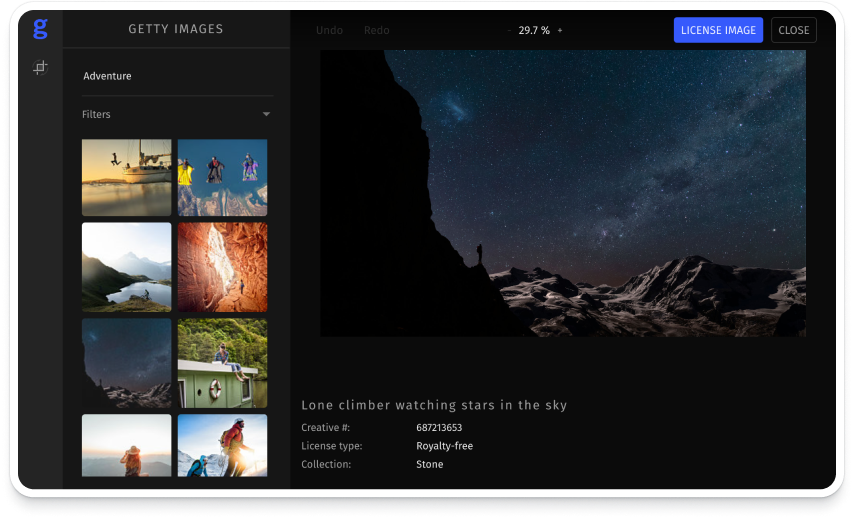Introduction to Getty Images

Welcome to the world of Getty Images, a treasure trove for visual content! Whether you're a marketer looking for captivating visuals or a blogger wanting to enhance your posts, Getty Images offers a vast library of photographs, illustrations, and videos. Founded in 1995, it has grown into a leading source for high-quality media. But before diving in, it's essential to grasp how to navigate their licensing structure to use images legally and ethically. Let’s explore this exciting journey together!
Also Read This: How to Cite Getty Images Photo in MLA: Correct MLA In-Text Citation for Getty Images
Understanding Image Licensing Basics
When it comes to using images from Getty, licensing is key. Here’s a breakdown of the basics to help you understand the options available:
What is Image Licensing?
Image licensing is essentially the legal permission granted by the copyright holder (in this case, Getty Images) to use their images under specific terms. Depending on the type of license, you’ll have different rights regarding how and where you can use the images.
Types of Licenses:
- Royalty-Free (RF): You pay a one-time fee for the image, allowing you to use it multiple times without additional costs. However, there are still restrictions on usage, such as not using the image for resale.
- Rights Managed (RM): This license is more restrictive and is based on how you plan to use the image. Costs can vary depending on factors like duration, location, and exclusivity. For instance, using an image in a global advertising campaign will cost more than a local brochure.
- Editorial Use Only: Images licensed for editorial use can’t be used for commercial purposes. They’re perfect for news articles, blogs, or educational projects where the image is relevant to the news or story being told.
Why Licensing Matters:
Using images without the proper license can lead to legal issues, including hefty fines. Getty Images takes copyright seriously, and violating their terms can result in legal action. By understanding licensing, you not only protect yourself but also respect the hard work of photographers and creators.
Tips for Choosing the Right License:
- Define Your Purpose: What do you need the image for? Is it for a commercial project or an educational article?
- Consider the Audience: Who will see the image, and how prominently will it feature in your work?
- Budget Wisely: Some licenses can be costly, so make sure to set a budget that allows for quality images without breaking the bank.
In summary, understanding image licensing is crucial for anyone looking to use Getty Images legally and effectively. Now that you're familiar with the basics, you can confidently explore the stunning visuals Getty has to offer, knowing you’re on the right side of copyright!
Also Read This: How to Filter by Agreement on Getty Images and Find What You Need
3. Creating an Account on Getty Images
Getting started with Getty Images is a breeze! If you're looking to access a vast library of high-quality images, creating an account is your first step. Here’s how to do it:
- Visit the Getty Images Website: Head to Getty Images. The homepage is user-friendly, so you won't feel overwhelmed.
- Sign Up: Look for the "Sign Up" or "Join" button, usually located in the upper right corner. Click it!
- Fill Out Your Details: You’ll be asked to enter some basic information like your name, email address, and a password. Make sure to choose a strong password to keep your account secure!
- Email Verification: After registration, you’ll receive an email from Getty Images. Click the verification link to activate your account. If you don’t see it, check your spam folder!
- Profile Setup: Once verified, log in and take a moment to set up your profile. Adding a profile picture and bio can make your account more personable, especially if you're using it for professional purposes.
And there you go! With your account created, you're ready to dive into the world of images. Creating an account not only allows you to license images but also enables you to save your favorite photos for future use. Plus, you can easily manage your licenses right from your account dashboard.
Also Read This: How Much Are Premium Access Photos on Getty Pricing and Options Explained
4. Searching for Images Efficiently
Now that you have an account, let’s talk about how to search for images efficiently on Getty Images. With millions of images available, it can be easy to get lost in the vast sea of visuals. Here are some tips to streamline your search:
- Use Specific Keywords: Instead of generic terms like "dog" or "city," try to be more specific. For example, search for “golden retriever running in a park” or “New York City skyline at sunset.” The more detailed your keywords, the more relevant your results will be.
- Utilize Filters: Once you perform a search, you’ll notice a variety of filters on the left sidebar. You can narrow down by category, orientation (horizontal or vertical), color, and even image type (photos, illustrations, or videos). This helps you find exactly what you need!
- Explore Collections: Getty Images often curates collections around themes, events, or trends. Check out sections like “Trending Now” or “Collections” for inspiration and to discover new images that fit your needs.
- Advanced Search Options: If you still can’t find what you’re looking for, try the “Advanced Search” feature. This allows you to combine multiple keywords and use Boolean operators (AND, OR, NOT) for a more tailored search.
- Save Your Searches: Found a search pattern that works? Save it! Getty Images lets you save your searches for quick access in the future. This is especially handy for frequent projects or ongoing campaigns.
By using these strategies, you'll not only save time but also enhance the quality of the images you find. Remember, the right image can make all the difference in your project, so take your time during the search process!
Also Read This: How to Search Multiple Tags on Getty Images: Advanced Search Tips
5. Filtering and Selecting the Right Images
When it comes to accessing Getty Images, the sheer volume of visuals available can be overwhelming. But fear not! With a few strategic steps, you can effectively filter and select the perfect images that align with your project’s needs.
First off, make use of the search bar. Type in relevant keywords that capture the essence of what you’re looking for. For example, if you're seeking images for a travel blog, try phrases like “tropical beaches” or “urban landscapes.” But don’t just stop there; explore variations and synonyms to broaden your search!
Next, leverage the filter options provided by Getty Images. Here’s a quick rundown of the most useful filters:
- Image Type: Choose from photos, illustrations, vectors, or videos.
- Orientation: Specify landscape or portrait to suit your layout.
- Color: Filter by dominant color to match your brand aesthetics.
- Style: Opt for editorial images, creative stock, or conceptual visuals.
Once you’ve narrowed down your choices using these filters, take a moment to review the image details. Click on an image to see its description, licensing options, and usage recommendations. This is crucial, especially if you’re planning to use the images for commercial purposes!
Another handy tip is to create lightboxes. This feature allows you to save and organize your favorite images as you browse. You can compare selections side-by-side and ultimately choose the best fit for your project.
Lastly, don't forget to consider the emotional impact of the images you select. The right image can evoke a feeling, tell a story, or complement your content perfectly. Think about your audience and what resonates with them. For instance, vibrant colors might be ideal for a children's brand, while muted tones may suit a corporate presentation.
Also Read This: Understanding Earnings Potential on Adobe Stock
6. Understanding Pricing and Licensing Options
Now that you've found the perfect images, it's time to dive into the nitty-gritty of pricing and licensing options. Understanding these aspects is pivotal to ensuring that you're using images legally and ethically.
Getty Images offers several pricing structures based on the type of license you choose. Here’s a brief overview:
| License Type | Description | Price Range |
|---|---|---|
| Royalty-Free | One-time fee for unlimited use, often a great choice for marketing. | $50 - $500 |
| Rights Managed | Licenses based on specific usage, duration, and distribution. | $100 - $1,500+ |
| Editorial Use | For news or commentary, can’t be used for commercial purposes. | $50 - $300 |
When selecting a license, consider how you plan to use the image. Will it be for a one-off social media post, or will it feature prominently in a printed advertisement? This decision can significantly affect the cost.
Also, be aware of the usage restrictions tied to each license. For instance, some images may prohibit any modification, while others allow for creative edits. Always read the fine print to avoid potential legal issues.
Finally, if you're a frequent user of stock images, consider subscribing to Getty Images’ plans, which can offer significant savings on bulk purchases. This is especially beneficial for businesses that require a steady stream of visuals.
In summary, navigating Getty Images for the right visuals doesn’t have to be daunting. By effectively filtering your options and understanding the pricing and licensing intricacies, you can make informed choices that elevate your projects while staying compliant!
Also Read This: Legally Using Getty Images in Your Projects
7. How to Download Images
So, you’ve found the perfect image on Getty Images—now what? Downloading your chosen images is a straightforward process, but there are some important steps to follow to ensure you’re doing it right.
First, let’s quickly go over the types of licenses you might encounter:
- Royalty-Free (RF): You pay a one-time fee and can use the image multiple times.
- Rights-Managed (RM): You pay based on specific usage, such as duration, geography, and medium.
- Editorial Use Only: These images can’t be used for commercial purposes, but are great for news articles or blogs.
Once you’ve selected an image that fits your needs, follow these steps to download:
- Add to Cart: Click on the “Add to Cart” button. This will direct you to your shopping cart, where you can review your selections.
- Review Your License: Make sure to double-check the licensing options available for the image. Understanding what you’re paying for is crucial!
- Proceed to Checkout: If everything looks good, hit the checkout button. You may need to create an account if you haven’t already done so.
- Download: After payment, you’ll receive a link to download your high-resolution image. Click it and save it to your device.
And that’s it! Just remember to keep track of the license agreements for each image, as you’ll want to reference them if any questions arise later.
8. Tips for Using Getty Images Legally
Using images legally is more than just a matter of downloading them. Here are some tips to ensure you’re always on the right side of the law when using Getty Images.
- Understand the License: Before you download, make sure you understand the specific terms of the license. Are there restrictions on how you can use the image? Knowing this upfront can save you from potential legal troubles down the line.
- Attribute Properly: For editorial images, ensure you're providing proper credit as required by Getty. This often includes the photographer's name and Getty's credit line.
- Stay Updated: Licenses can change. Periodically check back to ensure the usage you’re intending is still compliant with Getty’s current policies.
- Use the Image for Its Intended Purpose: If an image is licensed for editorial use only, don’t use it for commercial purposes! This can lead to serious repercussions.
- Archive Your License Agreements: Keep records of all your image licenses in one place. This way, you can easily reference them if needed.
By following these tips, you can enjoy the vast library of Getty Images while ensuring you’re using them legally. Happy downloading!
 admin
admin








